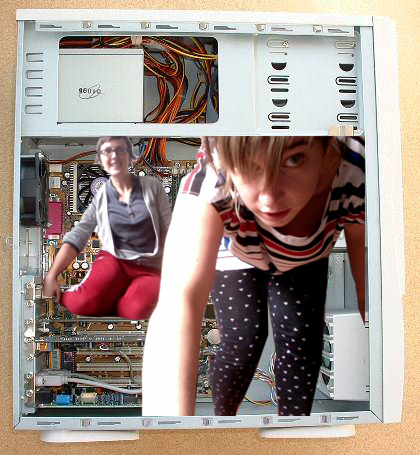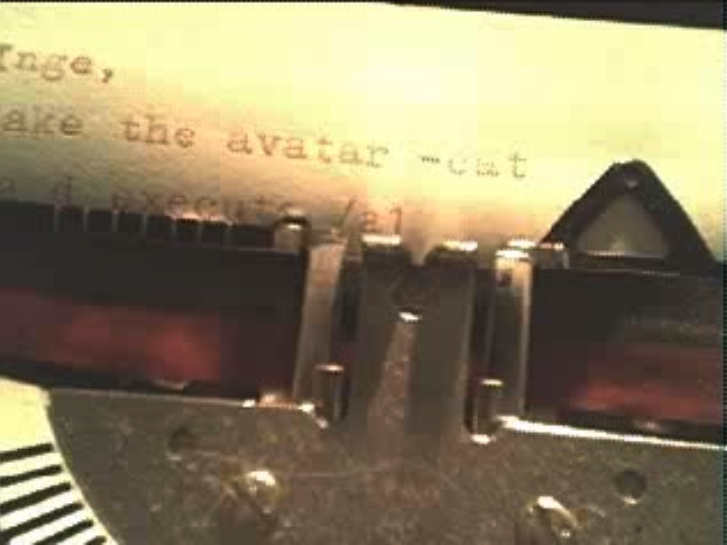User:Inge Hoonte/Is This On?: Difference between revisions
Inge Hoonte (talk | contribs) No edit summary |
Inge Hoonte (talk | contribs) No edit summary |
||
| Line 18: | Line 18: | ||
Is It On? works with the first steps of learning how to program. Sympathizing with the computer, unexpected love and jealousy between open source and proprietary software seem to form the perfect setting for a geek tragedy. Are we programmers, script-writers, designers, performers, button-pushers, hardware-hackers, sound nerds, or a bit of all? Where are opportunities to oppose, prove wrong, learn from and copy one another? | Is It On? works with the first steps of learning how to program. Sympathizing with the computer, unexpected love and jealousy between open source and proprietary software seem to form the perfect setting for a geek tragedy. Are we programmers, script-writers, designers, performers, button-pushers, hardware-hackers, sound nerds, or a bit of all? Where are opportunities to oppose, prove wrong, learn from and copy one another? | ||
For the practical application of our ideas, we chose to build virtual apartments into a desktop computer, which are projected into the UpStage platform. There are two apartments, one inhabited by the Proprietary family, and in the other one lives the Open Source family. The script is | For the practical application of our ideas, we chose to build virtual apartments into a desktop computer, which are projected into the UpStage platform. There are two apartments, one inhabited by the Proprietary family, and in the other one lives the Open Source family. The script is as much based on conflicts between Apple, Windows and Linux, as it is on the Montagues and the Capulets. The performance is about how the members of these groups communicate and seek connection in their differences and similarities through scripting, programs, software and analog means. | ||
Students, alumni and friends of Piet Zwart Institute are invited to join Inge and Birgit during a series of workshops to develop tools of storytelling with open source and/or proprietary software tools, create generative avatars and build DIY-electronic stages. As we're directly working with students in a studio environment, there's a natural habit to walk in and out and learn from one another, while also sharing lunch and watching movies in the same spaces. Within the department we're used to logging our work progress on a media wiki. UpStage enables us to push this social environment further online. | Students, alumni and friends of Piet Zwart Institute are invited to join Inge and Birgit during a series of workshops to develop tools of storytelling with open source and/or proprietary software tools, create generative avatars and build DIY-electronic stages. As we're directly working with students in a studio environment, there's a natural habit to walk in and out and learn from one another, while also sharing lunch and watching movies in the same spaces. Within the department we're used to logging our work progress on a media wiki. UpStage enables us to push this social environment further online. | ||
Revision as of 15:22, 9 October 2011
Sept 7
Birgit Bachler and I are working on an online performance event called IS THIS ON?
It's part of the UpStage project on 11/11/11, that we will host and stream live at PZI on Nov 11.
Last night, we set up the video stream to experiment with video avatars.
Earlier this week, we brainstormed and worked on code to enable random operation of the avatars on the screen.
Sept 9
Concept brainstorm. Stage will be a remodeled desktop hard drive, with apartments that are projected into it on UpStage. Actors/performers/operators are live in screen (in other parts of building). Also avatars. Avatar making workshop previous to performance. We'll provide script. CD drives are extended balconies.
Oct 9
Some PR
Is It On? works with the first steps of learning how to program. Sympathizing with the computer, unexpected love and jealousy between open source and proprietary software seem to form the perfect setting for a geek tragedy. Are we programmers, script-writers, designers, performers, button-pushers, hardware-hackers, sound nerds, or a bit of all? Where are opportunities to oppose, prove wrong, learn from and copy one another?
For the practical application of our ideas, we chose to build virtual apartments into a desktop computer, which are projected into the UpStage platform. There are two apartments, one inhabited by the Proprietary family, and in the other one lives the Open Source family. The script is as much based on conflicts between Apple, Windows and Linux, as it is on the Montagues and the Capulets. The performance is about how the members of these groups communicate and seek connection in their differences and similarities through scripting, programs, software and analog means.
Students, alumni and friends of Piet Zwart Institute are invited to join Inge and Birgit during a series of workshops to develop tools of storytelling with open source and/or proprietary software tools, create generative avatars and build DIY-electronic stages. As we're directly working with students in a studio environment, there's a natural habit to walk in and out and learn from one another, while also sharing lunch and watching movies in the same spaces. Within the department we're used to logging our work progress on a media wiki. UpStage enables us to push this social environment further online.
Through a mix of analog and digital means such as writing, hacking, scripting, programming, and soldering we aim to blur the boundaries between the real and the virtual. Webcams record physical spaces and the people performing in them, a screen that is then inserted into the online stage. This allows analog performers and digital avatars that appear on the screen to interact with one another. Real and virtual start to blend.
We aim to push cross-fertilization between our practices. Inge has more experience in writing and performing while Birgit has more of a programming background. In our collaboration for UpStage, programming influenced the script for example, and ideas for live performance influenced the code for how to operate the avatars.
# goofy sentence generator
import random
def make_sentence(part1, part2, part3, part4, part5, n=1):
"""return n random sentences"""
# convert to lists
p1 = part1.split('\n')
p2 = part2.split('\n')
p3 = part3.split('\n')
p4 = part4.split('\n')
p5 = part5.split('\n')
# shuffle the lists
random.shuffle(p1)
random.shuffle(p2)
random.shuffle(p3)
random.shuffle(p4)
random.shuffle(p5)
# concatinate the sentences
sentence = []
for k in range(n):
try:
s = p1[k] + ', take the avatar ' + p2[k] + ' and execute ' + p3[k] + ' make a move ' + p4[k] + ' and say ' + p5[k]
s = s.capitalize() + '.'
sentence.append(s)
except IndexError:
break
return sentence
# break a typical sentence into 5 parts
# p1: who in the audienc
part1 = """\
Birgit
Inge
The neighbor"""
# p2: which avatar
part2 = """\
tail
helen
cat"""
# p3: make action
part3 = """\
/a1
/a2
/a3"""
# p4: move avatar where?
part4 = """\
up the screen
bottom
left
anywhere"""
# p5: say this text:
part5 = """\
hallo
poop
goodbye
the world is great"""
print '-'*60
sentence = make_sentence(part1, part2, part3, part4, part5, 1)
for item in sentence:
print item
print '-'*60
"""
"""



